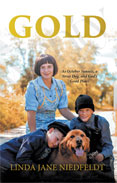
Author Niedfeldt has created a lively tale concerning a Russian immigrant family battling the woes of the Great Depression as they settle into America. The narrator is fifteen-year-old Lisenka, who works hard at home, helping Papa, stepmother Taty, and several siblings. While preparing a simple supper, Lisenka hears her young brother Yurgi screaming for help. She rushes outside to find him fighting with another boy for possession of one of their family’s precious chickens. The boy trying to steal the bird protests that “we have to eat” but is called off and pulled away by a gruff, grimy man. After the two slip away, Lisenka concludes that they are homeless people and will gradually come to learn much more about those known as “hobos”—the jobless, homeless, renegade, and desperate. Lisenka’s family, by contrast, have been fortunate In their chosen residence in Fond du Lac, Wisconsin, finding work, staying close, sustaining their religious faith, and maintaining basic cheer.
After prayer and discussion, Lisenka's family resolves to track down the young chicken thief, whose name is Jimmy. Their wish is to forgive the boy and share what largesse they have with him and his close group of street people. But it will prove far more difficult, and at times perilous, than they could have anticipated. Lisenka, at one juncture, must disguise herself as a boy for protection as she and her father, brothers, and friends roam the back streets looking for Jimmy. At the same time, Lisenka must keep up with household chores and work shifts at the city’s sock factory after Taty sustains an injury there. One surprising “assistant”— a bouncy, sweet-natured golden retriever who has a special role to play in the drama—will lead Lisenka and her loved ones to the fulfillment of their goal to aid little Jimmy.
Niedfeldt, a professional writer, photographer, and traveler, has composed several books such as this that reach out to young adult readers. Like this one, all of the books are titled with a symbolic color. She offers a sizzling storyline, both historical and metaphorical, an overarching respect for religion and family ties, and remarkably includes photographs that accompany her narrative. Since the book’s action takes place in the early days of the Great Depression, the photos are appropriately offered in black and white and provide a solid underpinning to Lisenka’s own observations. Lisenka is seen as strong, dark-haired, and with a determined air, while Jimmy’s crew are shown with unwashed faces and a stolid, protective attachment to one another.
The previous volumes follow Lisenka’s dramatic biography that is focused on the family’s migration and cohesion. The author avers that she has knowledge of real characters whose adventures provide her fictional focus, and she has chosen for her illustrations people whose faces, costumes, and actions match well the roles they play in her deftly constructed plot. These artistic touches put a highly creative stamp on Niedfeldt’s saga, offering numerous plot twists while clearly fostering empathy for her book’s major players. After reading this satisfying look at the life of Lisenka, Niedfeldt’s audience—new and established—will surely look forward to the next installments.
RECOMMENDED by the US Review
